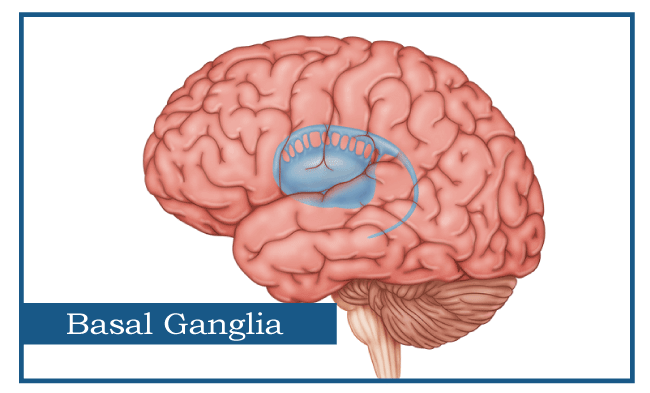Basal Ganglia FunctionA collection of subcortical structures located deep within the brain's white matter are known as the basal ganglia, sometimes known as the basal nuclei. They collaborate with the limbic and pyramidal systems and are a component of the extrapyramidal motor system. 
The nucleus, putamen, subthalamic nucleus, globus pallidus, and substantia nigra are the five pairs of nuclei that make up the basal ganglia. These nuclei are arranged in larger clusters, including Striatum, which also includes the:
Substantia Nigra and the Subthalamic NucleusThe basal ganglia are normally responsible for the fine-tuning voluntary movements. They accomplish this by receiving the upcoming movement's impulses from the cerebral cortex, which they then interpret and modify. In the end, the pyramidal motor system's tracts communicate the precise movement instructions to the skeletal muscles. Some higher cortical activities, including planning and controlling movement, memory, controlling eye movements, processing rewards, and motivation, are also mediated by the basal ganglia. OverviewOne of the parts of the brain network that regulates voluntary motor movement is the basal ganglia. The cerebral cortex is the top link in this network. It generates the instructions that specify how each skeletal muscle in the body moves. These instructions travel through the pyramidal system's pathways and connect with the motor neurons in the spinal cord's cranial nerve nuclei. The motor orders then proceed to the target muscles along the spinal and cranial nerves from this point. These cortical signals do, however, need to be modified and refined to some amount in order for their motor execution at the muscle level to proceed as smoothly and accurately as intended. The "accessory motor centres," of which the basal ganglia is the most significant, are where these modifications are made. The basal ganglia are physically different from one another, but they are connected by numerous connections, creating a strong functional unity. Although this name is less common today, the basal ganglia are referred to functionally as the extrapyramidal motor system. They take in information from numerous parts of the cerebral cortex, process it, and then send it back to the thalamus. The thalamus then transmits those more precise inputs to other parts of the brain, primarily the cortex and the brainstem. Phylogeny is defined as spinal cord and the reticular development of the brainstem are the oldest motor centres. Neostriatum (caudate nucleus and putamen) and the paleostriatum (globus pallidus) which are developed along with the cerebral cortex and were added to the brain as vertebrates evolved. The cerebral cortex and pyramidal system expanded during time and acquired a wide range of functional characteristics. As a result, the new, pyramidal motor system took over management of the extrapyramidal system, leaving it free to regulate the subtleties of cortical activity, or movement. FunctionsStudies examining the functions of the basal ganglia are still going on since we still don't fully understand what they do. However, the following roles have already been established in plain terms:
With the addition to it the basal nuclei compare the movement patterns produced by the cerebral cortex with the movement by using proprioceptive data from the periphery, allowing the movement to be continuously enhanced through a continuous servo-control system. Additionally, it has been demonstrated that the basal ganglia are very important for motivation. Extracellular dopamine exerts a strong influence on the basal ganglia circuits, and high levels have been associated with satisfied "euphoria," medium levels with wanting, and low levels with aversion. Prefrontal cortex and ventral striatum are activated as a result of the activation of the basal nuclei pathway, which also disinhibits the thalamus. It also proof that the globus pallidus, pars medialis, and subthalamic nucleus are basal ganglia regions that are involved in processing rewards. It has been demonstrated that the memory gates and concentration are controlled by the same prefrontal brain regions. By acting as a relay between the cerebral regions responsible for memory storage and the incoming information from the environment via the direct and indirect pathways of the basal ganglia.
Next TopicBlood Cancer
|
 For Videos Join Our Youtube Channel: Join Now
For Videos Join Our Youtube Channel: Join Now
Feedback
- Send your Feedback to [email protected]
Help Others, Please Share










